A Journey of Two Creators: Seeking Contemporary Stories and True Pansori
Pansori Project ZA regularly delights audiences with new works of pansori, or Korean epic chant, adapting a diverse selection of literature to the pansori form. The list includes Sacheon-ga and Ukchuk-ga, based on the plays of Bertolt Brecht; Stranger’s Song, based on a short story by Latin American literary master Gabriel García Márquez; and An Ugly Person/Murder, based on the Korean writer Ju Yo-seop’s short stories “Ugly Woman” and “Murder.” The group has reinvented the traditional Korean art form into something familiar, yet entirely new. This year the company chose to tell a story with great relevance to young people today. Titled Excuse Me, it is an adaptation of Korean writer Kim Ae-ran’s short story “No Knocking in This House.”
On one side of a bare stage, metronomes are lined up on an array of storage boxes—they draw the audience in with a cold and heavy vibe, suggesting that this piece, like the others, is going to be disquieting. sorikkun (narrative singer) LEE, Seung-hee, whose long black hair is pulled back into a neat braid as she holds a fan in her hand, puts on a smile pregnant with meaning. Sitting across from her is the gosu (lone drummer) LEE, Hyang-ha, responding to the sorikkun’s smile with her drum, as well as a few other instruments and props. No one expected to hear the vibrating sounds of an alarm clock or tones from a smartphone come out of the sorikkun’s mouth. Excuse Me edges up to the audience members with a story about the younger generation of this era, a story unlike anything Pansori Project ZA has shown us thus far.
I arranged an interview with LEE, Seung-hee and LEE, Hyang-ha, who are in search of new paths for pansori as part of Pansori Project ZA. I wanted to hear more about their lives, and about their thoughts on pansori and the value of tradition.
|
| |
| ▲ The author (left) with sorikkun (singer) LEE, Seung-hee and gosu (drummer) LEE, Hyang-ha © PARK, Ye-lim | |
Encounter
How did you first get involved in pansori and join Pansori Project ZA?
Lee Seung-hee: (Laughing.) I have to go back a long time to tell that story. I came to Seoul and studied at Korea National University of Arts. After finishing graduate school, I was already at an age where I should have been working as a professional sorikkun. I was introduced to various artists through acquaintances. If my memory serves me right, it was around 2009 that I heard Pansori Project ZA was looking for new sorikkun, so I auditioned. Then, through other ties, I got to meet the masters, such as Ms. Ahn Eun-me and Mr. Jang Young-gyu, and got involved in diverse projects.
Lee Hyang-ha: I majored in percussion in college. There are many concentrations students can choose from within percussion. Some choose court music, but during college I participated in projects by the Korean musical group Taroo, in which Lee Ja-ram was involved at the time. Then I started Pansori Project ZA with her in 2007, when she first decided to create Sacheon-ga. I must say that I wasn’t interested in pansori in the beginning, but was gradually drawn to it as I got involved in the production of Sacheon-ga and Ukchuk-ga after experiencing different things as a percussionist. I think my path as a pansori creator gradually took shape after that. I enjoy immensely being the sole percussionist in a pansori performance, and I feel that pansori is my calling now. I guess I could say that I went in the opposite direction compared with the way most people get involved in pansori. That is, I started out with creative pansori and went back to study (traditional) pansori in more depth. Prior to that, I did not know pansori all that well. (Laughing.)
Traditional pansori and Creative pansori
One of you went from traditional pansori to creative pansori, and the other vice versa, but you both are adding depth to the genre. What would you say the intrigue of pansori is for you?
Lee Hyang-ha: To me, pansori is just so much fun. I used to like narrated children’s stories a lot as a child. Someone telling me stories—isn’t that just great? A pansori is a story told by a sorikkun, which is what makes it particularly comforting and intriguing. Musically, I think the rhythms and certain nuances are conveyed in a very sophisticated manner. Above all, the way that a story unfolds through the two performers—the sorikkun and the gosu—who have nothing and no one else to depend on, but just the two of them, is the most intriguing aspect of pansori for me. The sorikkun deploys her voice, and as gosu I do my part by finding my own sounds to convey from my position. That is the beauty of it.
Lee Seung-hee: When I was performing pansori at a young age, I don’t think I really concentrated on the story. I was only obsessed with how my voice came out through my vocal cords—so I just focused on the techniques to draw out high pitches or articulate pronunciations. However, when I was performing in Sacheon-ga with pansori Project ZA, I had a chance to experience direction, which does not exist in traditional pansori, and was told a great deal about the story itself. Sacheon-ga had already premiered, so I could hear a lot of explanations and stories that helped me understand the piece better. That is when it struck me for the first time that a pansori was a story. My vocal rendition was of course important; but to keep the story going smoothly from beginning to end became a crucial matter to me, which made me see a different aspect of pansori. Every story was different depending on how the story was told and which sorikkun delivered it. Everyone can deliver it in a different manner to create a different kind of entertainment, and that makes pansori interesting.
Lee Hyang-ha: Since we could gain a thorough understanding of each piece before performing, it was easier to concentrate on the story and immerse ourselves in it. When I tried this before, I listened to the traditional pansori performed by the masters as well—in other words, understand the story first—and the impact was just amazing. It is certainly true that the more we understand, the more we see.
|
| |
| ▲ Excuse Me © pansori Project ZA | |
Although there are quite a few differences between traditional pansori and creative pansori, in your attempt at creative pansori, you still maintain the traditional format of sorikkun and gosu as the two sole performers. What are some things that you deem most important in the creative process?
Lee Hyang-ha: In traditional pansori, the sorikkun trains under a master to inherit the master’s voice, so to speak, and reach mastery through stage performances. In creative pansori, however, one starts from finding the story and incorporates everything one has to create the final result, which is radically different from the former. In our creative process, the most important thing is the question of “what constitutes true pansori?” It is difficult to answer this in one sentence—but to sum it up, there is the format of one sorikkun and one gosu on the stage. Also, to constitute true pansori, there are other things that we associate with pansori in the way of storytelling and musical aspects. We are always in the process of seeking what it is. For instance, there are many situations when we start out experimenting all sorts of ways, but end up trimming off everything and leaving only the most basic elements.
Lee Seung-hee: When we were creating Excuse Me, Hyang-ha and I had to write songs and lyrics and find the right musical arrangement for the script. When the same drumbeats came out repeatedly, we would get sick of them and try different things; but then, we would immediately agonize over whether we’d made the right choice and try going back to the basics. Sometimes, the very basic traditional beats seem to fit perfectly, and at other times, newly discovered beats seem more appropriate. So we always think things over.
Lee Hyang-ha: To me, what defines a true pansori is that it is fundamentally a story delivered by a sorikkun. Whatever story or philosophy we want to convey, we must do it through the voice of the sorikkun—hence, we strive to find the most fitting ways to express it. Lee Ja-ram, the director and scriptwriter, is also a sorikkun, which makes it easier for us to collaborate. We work together to find out what the sorikkun wants and understands. Also, an important thing in creating pansori is contemporariness. We try to discover a story that does not feel obsolete or like someone else’s story, but one that we can relate to and is valid in our present day—one that feels like my own, my mother’s, or my friend’s story.
Lee Seung-hee: Excuse Me is a perfect example of this. This was the second time we created pansori based on Korean short stories—the first was An Ugly Person/Murder, which was an adaptation of Ju Yo-seop’s short stories. Also, it was the first time we used a story written by a young, living writer. Using 2016, the present day, as the setting was another first for us—and initially it was all very unfamiliar.
Work
Kim Ae-ran’s short story “No Knocking in This House” was chosen as the basis for your work, Excuse Me. What was your reason for choosing that short story?
Lee Hyang-ha: The project began after Ja-ram read Kim Ae-ran’s collection of short stories and she liked it so much that she wanted to turn it into pansori. She proposed Seung-hee as the sorikkun for this project, rather than herself, because she saw Seung-hee as a better fit.
Lee Seung-hee: When I first began reading the story, I thought it was just a trifling story about a young woman who overcomes the hardships that she faces in her life. Yet, when I got to the scene with the identical rooms, it almost gave me chills. The story felt like some sort of fantasy, and I began to worry and panic about how to turn this into pansori. Part of what makes pansori fun is that multiple characters pop up and bustle about in one narrative, but this story has no notable action and consists solely of the thoughts and conjectures of a woman. Then the story turns into something that makes it difficult to tell whether any of it is true, or if it’s all in the woman’s imagination. It was a huge task to create pansori out of a story that had no narrative development, let alone a climax.
Lee Hyang-ha: I personally liked Kim Ae-ran’s fiction, so I welcomed the suggestion when I heard that we would be making her story into pansori. However, when I came back home and reread the book, I understood what Seung-hee was talking about. Yet, the more we discussed it, the stronger my desire to render it into pansori grew. In the end, it was a question of empathy. I read contemporariness from the story, and questions arose in me that we could address to the audience and to other people of our own time.
Lee Seung-hee: Both Hyang-ha and I came to live here all by ourselves—neither of us is from Seoul. The main character of the story lives in a boarding house in an unfamiliar society, so we could relate to her. I don’t know who lives next door to me, and when I hear my neighbors go out, I even wait for them to leave before I step out. I think it was even worse when I was younger. I could not form empathy with people, but I don’t think it was necessarily my personal choice. I believe we were placed in situations where we could not avoid isolating ourselves.
|
| |
| ▲ Excuse Me © pansori Project ZA | |
Communication
In pansori, communication with the audience is paramount. What was the audience response like when you performed at Doosan Art Lab earlier this year?
Lee Hyang-ha: Some said the use of metronomes was fresh, and others said they found it terrifying. When we first placed the metronomes there, we only thought of the tonal effects they could give, but it turned out they played quite an effective role in creating the contrast between the regulated and cold ambience in the first part of the story and the confusion that followed. Of course, what we heard the most was that it was quite refreshing to encounter through pansori a story that they had experienced in their own daily lives.
Lee Seung-hee: Our previous work An Ugly Person/Murder was a performance practically devoid of any communication with the audience. In comparison, this piece had no events, but we added the brand names that young audience members are familiar with in our line such as Dr. Marten or Etude House, which seem to have amused the audience and made them react quite enthusiastically.
Lee Hyang-ha: While the audience response at the Lab was just a product of coincidence, rather than something we anticipated, we are planning to build on it to include more things that can enhance communication with the audience when we present it at the Seoul Performing Arts Festival in October. In traditional pansori, eliciting chuimsae—short verbal sounds or words of encouragement—from the audience is an important part of communication, and we think it’s a defining feature of true pansori that we need to work on more. In An Ugly Person/Murder, we deliberately cut that part out, but as we performed a couple of times more, we simultaneously found ways to communicate with the audience under the conditions we had to work with. I think the relationship with the audience is extremely important.
|
| |
| ▲ Excuse Me © pansori Project ZA | |
The role of the gosu is also crucial in bringing out reactions from the audience. How do you think your role as a gosu in creative pansori differs from that in traditional pansori?
Lee Hyang-ha: When we work on the piece in the practice room, I focus on the straightforward relationship with the sorikkun; but when I meet the audience, my mind seems to naturally gear toward forming a triangular relationship. I assume the same thing happens to sorikkun as well. We create the triangular relationship, and handle every situation flexibly within that relationship. The difference between the gosu’s role in traditional pansori and creative pansori is that, in the former, one uses what one has acquired within the framework of the drumming rules (gobeop), and then makes instant judgments and improvises. For instance, in a traditional pansori, a gosu is considered to have played well if he or she played the drum in a manner befitting the drama, the sorikkun’s condition and the nuance of the words. This is referred to as “playing the drum befitting the imyeon (which can simultaneously mean the ‘hidden side’ and ‘order’).” Using that reference, I guess I can say that a gosu in a creative pansori not only “plays” the drum, but “creates” one befitting the imyeon. In other words, a gosu may choose different instruments, construct rhythm, receive directions about the performance, and so forth, which all contribute to “creating” the perfect sound. What distinguishes them could perhaps be summed up like thus: the gosu as the performer and the gosu as the creator. To find the right sound and tone, I could look for a new instrument, play with the rhythm, and occasionally use the elements of traditional drumming to create something befitting either the order or what is hidden inside.
In Excuse Me, I used a drum and a janggu (double-headed drum with a narrow waist in the middle) among the traditional instruments and a triangle among the Western instruments. In addition to that, I also utilized a water bottle, a rice bowl, and a wooden stick to create a set of everyday objects that I chose to represent the main character’s mind. At first, I thought of using so many instruments that I could not hold them all even if I used all my fingers, but I ended up going back to the drum as my main instrument. It has the most layers of sound and befits my energy the best.
Meeting the International Audience
Since your work has been selected for the 2016 PAMS Choice, you will be performing for international audience as well as Korean audience. How do you plan to create empathy within the international audience?
Lee Hyang-ha: What we discussed the most in our process of creating this work was social media. Anonymity and using formulaic methods to express oneself—these seem to resemble the identical rooms appearing in the story. For example, we can find many similar pictures with the same hashtag posted on Instagram by different people. Everyone is expressing one’s own individuality through certain things, but they end up looking the same. In our work, the objects that the main character chose to represent her individuality were Dr. Marten shoes and Etude House cosmetic products, but those are things defined by the society. She thought she was the only one using them, but everyone else was using the same thing. Her room looked exactly the same as the others’ rooms. These are the aspects that we thought would convey a certain universality and contemporariness to the international audience.
Lee Seung-hee: This era in which young people are living is so tough. It is hard for them to find a job or make money. Not only in Korea, but everywhere, so many young people seem to be idling away their time helplessly. They could hold their heads up high and greet one another if they were confident, but without confidence they just do things that they find comforting. They stare at smartphones, sit around doing nothing, and don’t go out anywhere. I think younger people, even if they are not from Korea, will find some things that they can relate to in what we portray.
Lee Hyang-ha: We are trying to develop an open-ended story, in which people such as our own mothers, brothers, sisters, uncle, or even foreigners can find something they can sympathize with in some tiny little corner of what is going on in the life of this twenty-something female character.
|
| |
| ▲ sorikkun LEE, Seung-hee and gosu LEE, Hyang-ha © PARK, Ye-lim | |
Tradition
As a sorikkun and a gosu working on creative pansori, what is your view of tradition?
Lee Seung-hee: I do not separate tradition from what I do. I am engaging in creative pansori, but I still practice and perform traditional pansori pieces from Chunhyang-ga, Sugung-ga, and Simcheong-ga. I think that the key to building relationships in creative pansori lies with my ties to traditional pansori. If I excluded tradition and only worked on creative pansori, I might neglect fundamental questions pertaining to pansori and focus only on how to make my performance more glamorous, stylish, or entertaining.
Lee Hyang-ha: As I said before, my interest in traditional pansori increased only after I started working on creative pansori. So, for me, tradition is not something that I can separate from creative pansori by drawing a clear line. My understanding of pansori deepened with my involvement in creative pansori; and, in turn, I came to rediscover the roles of sorikkun and gosu in the traditional format through that involvement. That, I think, is the power of tradition. As my understanding of the genre deepened, I was able to see the freedom within that genre, which lived on for hundreds of years. When I listen to the performances of some teachers or masters, I can feel that they are creating and performing freely. For them, that is the tradition, and that is the art to which they have devoted their entire lives. When I hear drum sounds that make me wonder whether it would be all right to play it that freely, I rethink the notion of tradition. In other words, to them, it is still the music of today and not of mere tradition. Through them, I acquire new perspectives on tradition and art.
The Path of the Artist
Lee Seung-hee: I have more opportunities to work on pansori now than I used to. So I think more about not going down a path that is too absurd or far-fetched. I try to find more entertaining aspects within the basic format of pansori. What matters the most is finding the right story and material—something that many people can enjoy and relate to. Using my own voice is what I can do best and how I can communicate with the world. I find it intriguing to deliver the story through my voice. One day, if I no longer find pansori interesting, I may quit, but now is not the time. I still find it intriguing, and am surprised at how many people come to watch our performance and how the audience discovers things that even the creators could not. That is why I continue to go down this path of creating pansori.
Lee Hyang-ha: When I work with Seung-hee, I can feel her presence as a sorikkun from her remarkable concentration, unbelievable tenacity, and healthy ambition in pansori. I, myself, seem to take on a different identity when I participate in pansori as a gosu as opposed to when I play other percussion instruments or perform in a band. I do not remain a percussionist who plays the instrument using my techniques, but struggle to determine what my role as a gosu in a pansori is by getting actively involved in the story, experiencing it along with the audience, and taking on other roles. When I first participated in Sacheon-ga, my main concern was to find out what I should do to express myself musically; but now, I often feel like I am another narrator of the story who speaks with my body, eyes, and drum, sitting next to the sorikkun, who delivers her story through her voice.
To the Audience
Lee Seung-hee: For people, it seems that watching pansori is somewhat different watching a play. I hope people would just come with a light heart to listen to an interesting story, rather than picturing sorikkun in front of the folding screen. Following the story and enjoying moments after moments of it—I would think that is what it means to enjoy pansori.
Lee Hyang-ha: I can state with the utmost confidence that pansori is fun, because the gosu is the audience member who sits in the front row. I get to be in the first row and watch everything first, the most often and the most closely. I am in the simultaneous position of creator and audience. The more I experience it, the more I find pansori to be an intriguing genre.








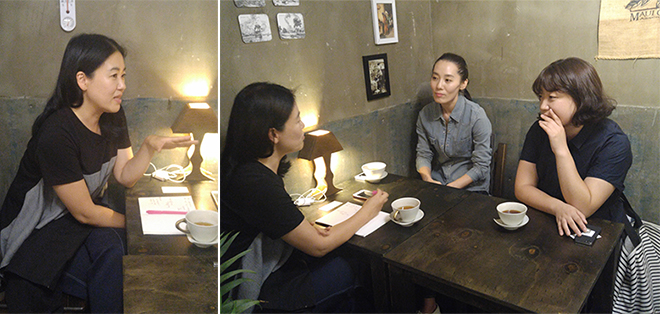
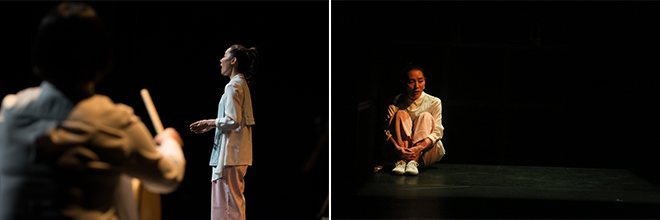
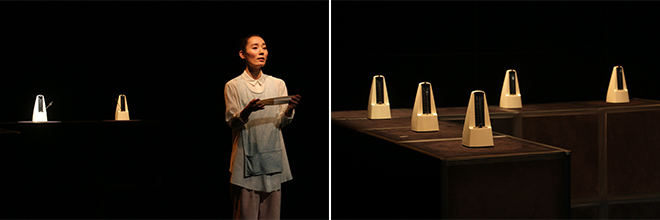
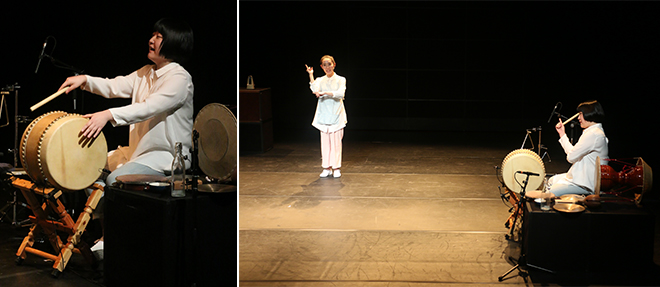
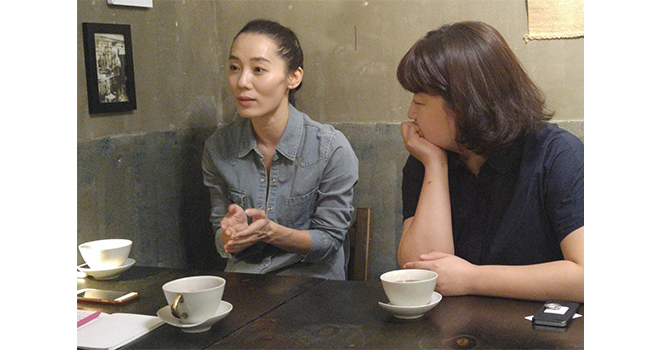
 PREV
PREV
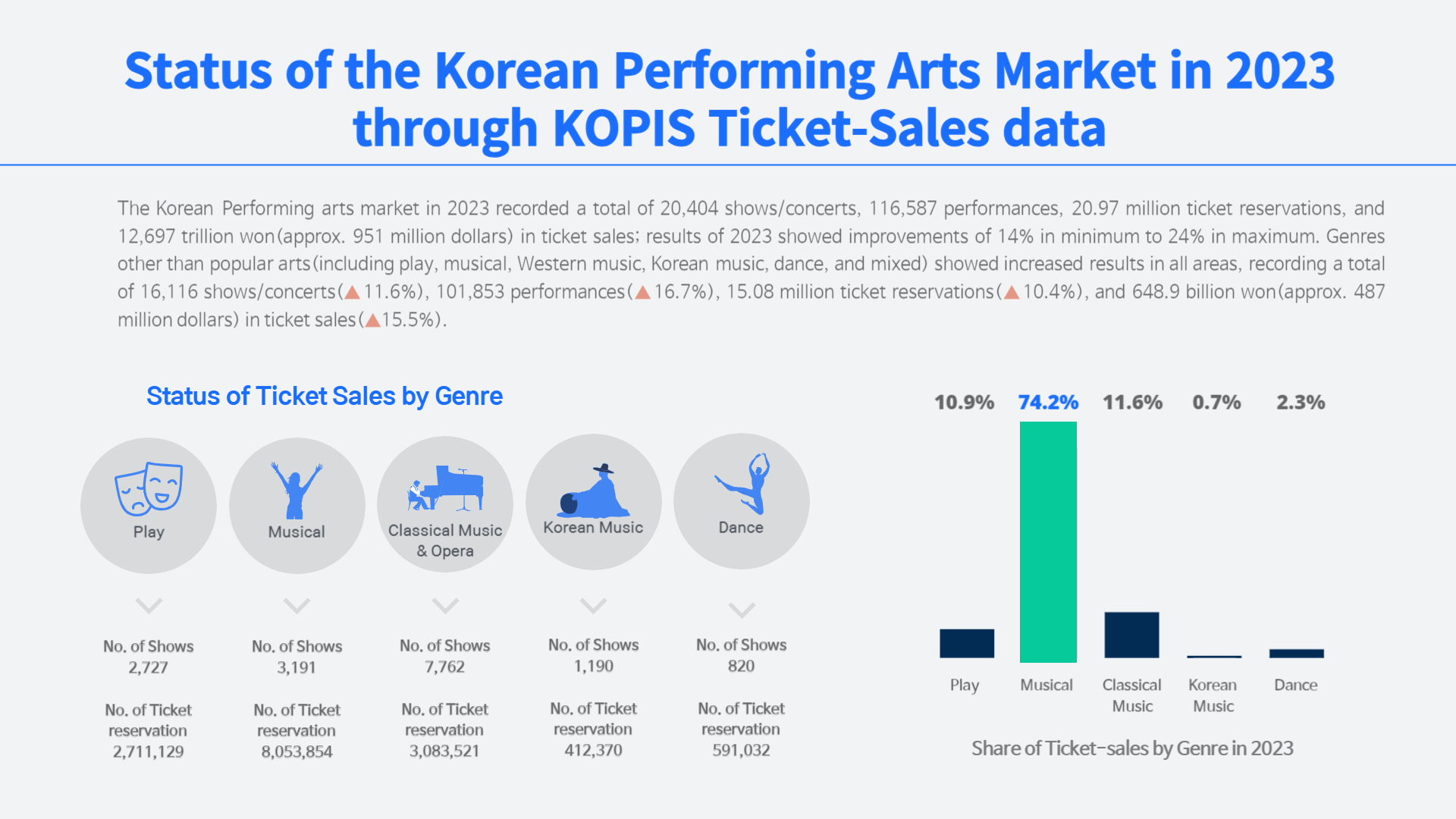
.jpg)
.jpg)
.jpg)
.jpg)











